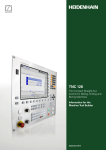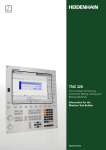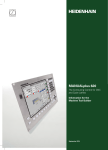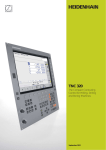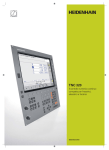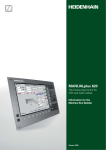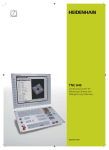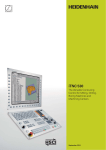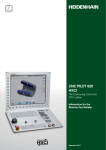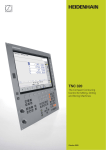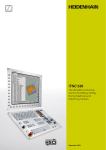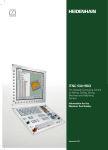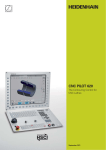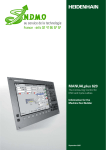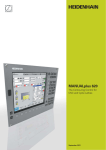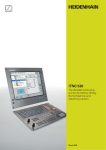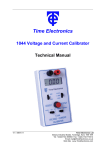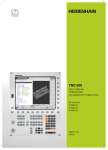Download Heidenhain TNC 320 catalogue
Transcript
TNC 320 The Compact Contouring Control for Milling, Drilling and Boring Machines Information for the Machine Tool Builder September 2012 TNC contouring control from HEIDENHAIN General information TNC 320 • Contouring control for milling machines • Up to 5 axes and closed-loop main spindle • Analog command interface to the drives (± 10 V) • Compact design: Screen, keyboard and computer all in one unit • Dimensions: 400 mm x 470 mm x 100 mm • Integrated 15-inch TFT color flat-panel display • Storage medium for NC programs: CompactFlash memory card • Programming in HEIDENHAIN conversational language • Standard milling, drilling and boring cycles • Touch probe cycles • Short block processing time System test Controls, motors and encoders from HEIDENHAIN are in most cases integrated as components in larger systems. In these cases, comprehensive tests of the complete system are required, irrespective of the specifications of the individual devices. Expendable parts In particular the following parts in controls from HEIDENHAIN are subject to wear: • Buffer battery • Fan Standards Standards (ISO, EN, etc.) apply only where explicitly stated in the catalog. Note Microsoft Windows, Windows 2000, Windows XP, Windows Vista, Windows 7 and the Internet Explorer are registered trademarks of Microsoft Corporation. Validity The features and specifications described here apply for the following control and NC software versions: TNC 320 with NC software version 340551-06 (no export license required) This catalog supersedes all previous editions, which thereby become invalid. Subject to change without notice. Prerequisites 2 Some of these specifications require particular machine configurations. Please note also that, for some functions, a special PLC program must be created by the manufacturer. Contents TNC contouring control from HEIDENHAIN 2 Overview tables 4 Control components 12 Accessories 17 Cable overviews 23 Technical description 25 Data transfer and communication 39 Mounting information 42 Overall dimensions 44 General information 54 Other HEIDENHAIN controls 56 Subject index 58 Please refer to the page references in the tables with the specifications. 3 Overview tables Overview of TNC 320 components Control system TNC 320 Page Main computer MC 320 12 Storage medium CFR CompactFlash memory card 12 NC software license On SIK component 12 Visual display unit 15-inch color flat-panel display (integrated) Operating panel Integrated Machine operating panel MB 420 15 Encoder input board Necessary as of 4 axes and closed-loop spindle 13 Connecting cables ✓ 23 4 Accessories Accessories TNC 320 Electronic handwheels • • • • • Workpiece touch probes Tool touch probes HR 410 portable handwheel or HR 520 portable handwheel with display or HR 550 FS portable wireless handwheel with display or HR 130 panel-mounted handwheel or Up to three HR 150 panel-mounted handwheels via HRA 110 handwheel adapter • TS 220 touch trigger probe with cable connection or • TS 440 touch trigger probe with infrared transmission or • TS 444 touch trigger probe with infrared transmission or • TS 640 touch trigger probe with infrared transmission or • TS 740 touch trigger probe with infrared transmission • TT 140 touch trigger probe or • TS 449 touch trigger probe with infrared transmission or • TL Nano laser system for contact-free workpiece measurement or • TL Micro laser system for contact-free workpiece measurement Page 19 17 18 PLC input/output system For additional internal PLC inputs and outputs PL 510 consisting of PLB 51x basic module and I/O modules 16 USB hub ✓ 40 Programming station Control software for PCs for programming, archiving, and training • Single-station license with original control keyboard • Single-station license with virtual keyboard • Network license with virtual keyboard • Demo version with virtual keyboard or PC keyboard—free of charge Snap-on keys *) *) 22 For further information, refer to the TNC Programming Station brochure. Accessories / Software TNC 320 Page PLCdesign1) PLC development software 36 KinematicsDesign1) Software for creating kinematics and initializing DCM 31 TNCremo2) Data transfer software 40 TNCremoPlus2) Data transfer software with “live” screen 40 ConfigDesign1) Software for configuring the machine parameters 33 CycleDesign1) Software for creating cycle structures 38 Software Key Generator1) Software for enabling SIK options for a limited time 12 TNCscope1) Software for data recording 33 TeleService1) Software for remote diagnostics, monitoring, and operation 34 RemoTools SDK1) Function library for developing customized applications for communication with HEIDENHAIN controls 41 1) 2) Available to registered customers for downloading from the Internet Available to all customers (without registration) for downloading from the Internet 5 Specifications Specifications TNC 320 Page Axes 3 closed-loop axes, optional: 4th and 5th axis 25 PLC axes ✓ 25 Central drive ✓ 25 Open-loop axes ✓ 25 Spindle Max. 2; second spindle can be controlled alternately with the first Analog nominal speed value Up to 100 000 min–1 Digital control over PLC outputs ✓ Position-controlled spindle ✓ 27 Oriented spindle stop ✓ 27 Gear shifting ✓ 27 Linear axes 0.1 μm 25 Rotary axes 0.0001° 25 Straight line 4 of 5 axes * Circle 2 of 5 axes * Helix ✓ * Axis feedback control Analog speed command interface ± 10 V (X8) 29 With following error ✓ With feedforward ✓ 27 NC program memory Input resolution and display step Interpolation Cycle times Block processing 6 ms Path interpolation 3 ms Permissible temperature range Operation: In electrical cabinet: 5 °C to 40 °C In operating panel: 0 °C to 50 °C Storage: –20 °C to 60 °C * 6 For further information, refer to the TNC 320 brochure 29 Machine interfacing Machine interfacing TNC 320 Page Error compensation ✓ 32 Linear axis error ✓ 32 Nonlinear axis error ✓ 32 Backlash ✓ 32 Thermal expansion ✓ 32 Integrated PLC ✓ 35 Program format Statement list 35 Program input on the TNC Via external USB keyboard 35 Program input via PC ✓ 35 Symbolic PLC-NC interface ✓ 35 PLC memory 50 MB 35 Typically 21 ms, adjustable 35 31 (expandable via PL); additional 25 on machine operating panel 16 PLC outputs, 24 V DC1) 31 (expandable by PL) 16 Analog inputs, ± 10 V Via PL 16 Inputs for PT 100 thermistors Via PL 16 Analog outputs, ± 10 V Via PL 16 PLC functions ✓ 35 Small PLC window ✓ 35 PLC soft keys ✓ 35 PLC positioning ✓ 36 PLC basic program ✓ 37 PLC cycle time PLC inputs, 24 V DC1) Integration of applications 36 High-level language programming Python programming language used in combination with the PLC (option 46) 36 User interfaces can be customdesigned 36 1) Inclusion of specific user interfaces from the machine tool builder (option 46) Further PLC inputs/outputs via PL 510 for connection to MC 7 Machine interfacing TNC 320 Commissioning and diagnostic aids Page 33 ConfigDesign Software for creating the machine configuration 33 Integrated oscilloscope ✓ 33 Trace function ✓ 34 API DATA function ✓ 34 Table function ✓ 34 OnLine Monitor (OLM) ✓ 33 Log ✓ 34 TNCscope ✓ 33 Commissioning wizard For analog axes Data interfaces ✓ Ethernet (100 BaseT) ✓ 39 USB 2.0 2 on the rear, 1 on the front 39 RS-232-C/V.24 ✓ 39 Protocols 39 Standard data transfer ✓ 39 Blockwise data transfer ✓ 39 LSV2 ✓ 39 Encoder inputs 28 Position 4 (optional: 5) 28 Incremental 1 VPP 28 Absolute EnDat 2.1 28 1) 8 Further PLC inputs/outputs via PL 510 for connection to MC Brief description TNC 320 Option User function Standard User functions ✓ Basic version: 3 axes plus spindle 1st additional axis for 4 axes and closed-loop or open-loop spindle 2nd additional axis for 5 axes and open-loop spindle 0 1 Program entry ✓ ✓ HEIDENHAIN conversational DIN/ISO via soft keys or via external USB keyboard Position entry ✓ ✓ ✓ Nominal positions for lines and arcs in Cartesian coordinates or polar coordinates Incremental or absolute dimensions Display and entry in mm or inches Tool compensation ✓ ✓ Tool radius in the working plane and tool length Radius-compensated contour look-ahead for up to 99 blocks (M120) Tool tables ✓ Multiple tool tables with any number of tools Constant contour speed ✓ ✓ Relative to the path of the tool center Relative to the tool’s cutting edge Parallel operation ✓ Creating a program with graphical support while another program is being run Rotary table machining 8 8 Programming of cylindrical contours as if in two axes Feed rate in distance per minute Contour elements ✓ ✓ ✓ ✓ ✓ ✓ ✓ Straight line Chamfer Circular path Circle center point Circle radius Tangentially connecting circular arc Corner rounding Contour approach and departure ✓ ✓ Via straight line: tangential or perpendicular Via circular arc FK free contour programming ✓ FK free contour programming in HEIDENHAIN conversational format with graphic support for workpiece drawings not dimensioned for NC Fixed cycles ✓ ✓ ✓ ✓ ✓ ✓ ✓ ✓ ✓ ✓ ✓ Drilling, tapping with a floating tap holder, rigid tapping Rectangular and circular pockets Peck drilling, reaming, boring, counterboring, centering Milling internal and external threads Clearing level and oblique surfaces Multioperation machining of straight and circular slots Multioperation machining of rectangular and circular pockets Cartesian and polar point patterns Contour train, contour pocket OEM cycles (special cycles developed by the machine tool builder) can be integrated Engraving cycle: Engrave text or numbers in a straight line or on an arc 9 TNC 320 Option Standard User function Program jumps ✓ ✓ ✓ Coordinate transformation ✓ Q parameters Programming with variables ✓ ✓ ✓ ✓ ✓ Mathematical functions =, +, –, *, /, sin α, cos α, tan α, arc sin, arc cos, arc tan, an, en, ln, log, angle α of sin α and cos α, square root of a, square root of (a2 + b2) Logical operations (=, = /, <, >) Calculating with parentheses Absolute value of a number, constant π, negation, truncation of digits before/after decimal point Functions for calculation of circles Programming aids ✓ ✓ ✓ ✓ ✓ ✓ Calculator Complete list of all current error messages Context-sensitive help function for error messages TNCguide: The integrated help system. User information available directly on the TNC Graphic support for programming cycles Comment and structure blocks in the NC program Actual position capture ✓ Actual positions can be transferred directly into the NC program Test graphics Display modes ✓ ✓ ✓ Graphic simulation before a program run, even while another program is running Plan view / projection in 3 planes / 3-D view, also in tilted working plane Magnification of details Interactive programming graphics ✓ In the Programming and Editing mode, the contour of the NC blocks is drawn on screen while they are being entered (2-D pencil-trace graphics), even while another program is running Progr.-run graphics Display modes ✓ ✓ Graphic simulation during real-time machining Plan view / projection in 3 planes / 3-D view Machining time ✓ ✓ Calculation of machining time in the Test Run operating mode Display of the current machining time in the Program Run operating modes Returning to the contour ✓ ✓ Mid-program startup in any block in the program, returning the tool to the calculated nominal position to continue machining Program interruption, contour departure and return Datum managem. ✓ For saving any reference points Datum tables ✓ Several datum tables for storing workpiece-related datums Touch probe cycles ✓ ✓ ✓ ✓ Touch probe calibration Compensation of workpiece misalignment, manual or automatic Datum setting, manual or automatic Automatic tool and workpiece measurement Parallel secondary axes ✓ ✓ Compensating movement in the secondary axis U, V, W through the principal axis X, Y, Z Including movements of parallel axes in the position display of the associated principal axis (sum display) Defining the principal and secondary axes in the NC program makes it possible to run programs on different machine configurations Subprograms Program-section repeat Calling any program as a subprogram 8 ✓ Conversational languages ✓ 41 10 Datum shift, rotation, mirror image, scaling factor (axis-specific) Tilting the working plane, PLANE function English, German, Chinese (traditional, simplified), Czech, Danish, Dutch, Finnish, French, Hungarian, Italian, Polish, Portuguese, Russian (Cyrillic), Spanish, Swedish For more conversational languages, see Options Options Option number Option As of NC software 34055x- ID Comment 0 Additional axis 01 ID 354540-01 Additional control loop 1 1 Additional axis 01 ID 353904-01 Additional control loop 2 8 Software option 1 01 ID 536164-01 Rotary table machining • Programming of cylindrical contours as if in two axes • Feed rate in distance per minute 03 Interpolation • Circular in 3 axes with tilted working plane Coordinate transformation • Tilting the working plane 04 PLANE function 18 HEIDENHAIN DNC 01 ID 526451-01 Communication with external PC applications over COM component 24 Gantry axes 04 ID 634621-01 Gantry axes in master-slave torque control 41 Additional language 01 ID 530184-01 ID 530184-02 ID 530184-03 ID 530184-04 ID 530184-06 ID 530184-07 ID 530184-08 ID 530184-09 ID 530184-10 Additional conversational language: Slovenian Slovak Latvian Norwegian Korean Estonian Turkish Romanian Lithuanian 01 ID 579650-01 Python application on the iTNC 46 Python OEM process 11 Control components Main computer TNC 320 The standard version of the TNC 320 features four inputs for position encoders. It can be enhanced with options. The TNC 320 includes the MC 320 main computer with: • Processor (INTEL® Celeron M, 1 GHz) • 1 GB SDRAM main memory • 15-inch TFT color flat-panel display; resolution 1024 x 768 pixels • TNC keyboard • PLC • Interface to handwheel and touch probes • Further interfaces (PLC expansion, Ethernet, USB 2.0, RS-232-C/V.24) To be ordered separately, and installed in the main computer by the OEM: • CFR CompactFlash memory card with the NC software • SIK component (System Identification Key) for enabling control loops and options MC 320 Position inputs Weight 4 x 1 VPP or EnDat (optional 5 x 1 VPP or EnDat) 7.9 kg ID 511442-xx Power supply Power supply Frequency Power consumption Storage medium A CFR (= CompactFlash Removable) compact flash memory card is used as storage medium. It contains the NC software and is used to store NC and PLC programs. The storage medium is removable and must be ordered separately from the main computer. CFR CompactFlash Free capacity for NC programs Free capacity for PLC programs No export license required SIK component 85 V AC to 264 V AC 47 Hz to 440 Hz 60 W 300 MB 50 MB ID 537067-51 The SIK component contains the NC software license for enabling control loops and software options. It gives the main computer an unambiguous ID code—the SIK number. The SIK component is ordered and shipped separately. It must be inserted in a special slot on the side of the TNC 320. The SIK component with the NC software license is available in various versions, depending on the enabled control loops and options. Further control loopscan be enabled later by entering a keyword. HEIDENHAIN provides the keyword, which is based on the SIK number. When ordering, please indicate the SIK number of your control. When the keywords are entered in the control, they are saved in the SIK component. This enables and activates the options. Should service become necessary, the SIK component must be inserted in the replacement control to enable all required options. Master keyword (general key) 12 There is a master keyword (general key) for putting the TNC 320 into service that will unlock all options for a duration of 90 days. After this period, only those options with the correct keywords will be active. The general key is activated via a soft key. CFR CompactFlash SIK component Software Key Generator (accessory) The PC software makes it possible to generate an activation code for software options on HEIDENHAIN controls. The selected option is enabled for a limited time (10 to 90 days). It can only be enabled once. You generate the desired activation code by entering the SIK number, the option to be enabled, the duration and a manufacturer-specific password. Option enabling is independent of the general key. NC software license SIK with software license and enabling for 4 control loops (3 axes and closed-loop spindle) 5 control loops (4 axes and closed-loop spindle) Axis options With the NC software license for three axes, two additional control loops can be enabled retroactively: 1st additional axis 2nd additional axis Encoder input board ID 354540-01 ID 353904-01 An additional encoder input board is required for configurations with five or more closed control loops. Encoder input board Possible configurations ID 533093-51 ID 533093-52 ID 554296-xx Closed-loop axes Spindle NC software license for Necessary options 3 Closed-loop 4 control loops – 4 Open-loop 4 control loops 1st additional axis 5 control loops – 4 control loops 1st additional axis Encoder input board 5 control loops Encoder input board 4 control loops 1st additional axis 2nd additional axis Encoder input board 5 control loops 2nd additional axis Encoder input board 4 control loops 1st additional axis 2nd additional axis 2 encoder input boards 5 control loops 2nd additional axis 2 encoder input boards 4 5 5 1) Closed-loop Open-loop Closed-loop For the open-loop spindle, the TNC commands an analog nominal speed value for the spindle speed. For the closed-loop spindle, position feedback is provided, for example for oriented spindle stop. 13 Options The capabilities of the TNC 320 can also be adapted retroactively with options to meet new requirements. These options are described on page 11. They are enabled by entering keywords based on the SIK number, and are saved in the SIK component. Please indicate your SIK number when ordering new options. TNC keyboard The keys for the axes Z, 4 and 5 are designed as snap-on keys and can be replaced by keys with other symbols (see Snap-on keys). Export license An export license is generally not required for the TNC 320 because the NC software limits the number of interpolatable axes to four. The 5th axis can be used for the spindle or as an auxiliary axis. 14 Machine operating panel MB 420 machine operating panel • 21 snap-on keys, freely definable via PLC • Operating elements • Assigned according to PLC basic program with: Control voltage on; Emergency stop; NC start; NC stop; 5 axis keys; Rapid traverse; Retract axis; Tool change; Unclamp tool; Menu selection; Unlock door; Spindle start; Spindle stop; Coolant; Rinse-water jet; Chip removal (for further symbol keys, see Snap-on keys) Additional connections Terminals for 3 PLC inputs and 8 PLC outputs MB 420 Weight MB 420 ID 293757-45 0.9 kg 15 PL 510 PLC input/output system PL 510 If the PLC inputs/outputs of the control do not suffice, additional PL 51x PLC input/output systems can be connected. These external modular I/O systems consist of a PLB 51x basic module and one or more PLD 16-8 and PLA 4-4 input/output modules. PL 510 Basic modules Basic modules feature slots for 4, 6 or 8 I/O modules. They are mounted on standard NS 35 rails (DIN 46 227 or EN 50 022). Power supply Power consumption Weight 24 V DC Approx. 20 W 0.36 kg (bare) Basic modules with HEIDENHAIN PLC interface PLB 510 Slots for 4 I/O modules PLB 511 Slots for 6 I/O modules PLB 512 Slots for 8 I/O modules ID 358849-01 ID 556941-01 ID 557125-01 Up to four PLB 510 modules, and up to two PLB 511 or PLB 512 modules can be connected to the control. The maximum cable length to the last PLB 51x is 30 m. I/O modules The I/O modules consist of one module with digital inputs/outputs and one analog module. For partially occupied basic modules, the unused slots must be occupied by an empty housing. PLD 16-8 ID 360916-11 I/O module for PL 5x0 with 16 digital inputs and 8 digital outputs. The maximum power output per module is 200 W. A load of up to 2 A can be placed on each output. No more than four outputs may be loaded with 2 A at any given time. Weight 0.2 kg PLA 4-4 ID 366423-01 Analog module for PL 5x0 with 4 analog inputs for PT 100 thermistors 4 analog inputs for ± 10 V Weight 0.2 kg Empty housing 16 For unused slots ID 383022-11 Accessories Touch probes Overview Before the TNC 320 leaves the factory, it is already prepared for the use of touch probes for workpiece or tool measurement. These touch probes generate a trigger signal that saves the current position value to the NC. For more information on the touch probes, ask for our brochure or CD-ROM titled Touch Probes. Workpiece measurement The TS touch trigger probes have a stylus for probing workpieces. The HEIDENHAIN controls provide standard routines for datum setting and workpiece measurement and alignment. The touch probes are available with various taper shanks. Assorted styli are available as accessories. Touch probe with cable connection for signal transmission for machines with manual tool change: TS 220 Touch probe for NC machines Touch probe with infrared signal transmission for machines with automatic tool change: TS 440 Compact dimensions TS 444 Compact dimensions, battery-free—power supply through integrated air turbine generator over central compressed air supply TS 640 Standard touch probe with wide-range infrared transmission and long operating time TS 220 TS 640 TS 740 High probing accuracy and reproducibility, low probing force SE transmitter-receiver unit The infrared transmission is established between the TS touch probe and the SE transceiver unit. The following SE units can be combined with the TS touch probes: SE 640 for installation in the machine’s working space SE 642 common SE for TS and TT 449; otherwise same as SE 640 SE 540 for installation in the spindle head SE 640 17 Tool measurement The touch probes for tool measurement from HEIDENHAIN are suited for probing stationary or rotating tools directly on the machine. The TNC 320 has standard routines for measuring length and diameter of the tool as well as the individual teeth. The TNC 320 automatically saves the results of measurement in a tool table. It is also possible to measure tool wear between two machining steps. The TNC 320 compensates the changed tool dimensions automatically for subsequent machining or replaces the tool after a certain limit—as for example after tool breakage. With the triggering TT touch probes the disk-shaped contact plate is deflected from its rest position upon contact with a stationary or rotating tool, sending a trigger signal to the TNC 320 control. TT 140 Signal transmission to the control over connecting cable TT 140 TT 449 Signal transmission over infrared beam to SE 642 transmitter/ receiver unit TL Micro/TL Nano The TL laser systems operate without any contact. A laser beam probes the length, diameter or contour of the tool. Special measuring cycles in the TNC 320 evaluate the information. TL Micro 150, TL Micro 300 18 Electronic handwheels Overview The standard TNC 320 supports the use of electronic handwheels. • HR 550 FS wireless handwheel, or • HR 410 or HR 520 portable handwheel, or • HR 130 panel-mounted handwheel • Up to three HR 150 panel-mounted handwheels via HRA 110 HR 410 Portable electronic handwheel with • Keys for the selection of 5 axes • Traverse direction keys • Keys for three preset feed rates • Actual-position-capture key • Three keys with machine functions (see below) • Two permissive buttons (24 V) • Emergency stop button (24 V) • Magnetic holding pads All keys are designed as snap-on keys and can be replaced by keys with other symbols (see Snap-on keys). HR 410 Keys W/o detent With detent FCT A, FCT B, FCT C ID 296469-53 – Spindle right/left/ stop ID 296469-54 – HR 410 NC start/stop, ID 296469-55 spindle start (for PLC basic program) ID 535220-05 Weight approx. 1 kg HR 520 Portable electronic handwheel with • Display for operating mode, actual position value, programmed feed rate and spindle speed, error messages • Override potentiometer for feed rate and spindle speed • Selection of axes via keys or soft keys • Actual position capture • NC start/stop • Spindle on/off • Keys for continuous traverse of the axes • Soft keys for machine functions of the machine manufacturer • Emergency stop button HR 520 W/o detent With detent ID 670302-01 ID 670303-01 Weight approx. 1 kg HR 520 Mount for HR 520 For fastening on machine ID 591065-02 19 HR 550 FS Electronic handwheel with wireless transmission. Display, operating elements and functions same as HR 520. In addition: • Functional safety • Wireless transmission range up to 20 m (depending on environment) HR 550 FS W/o detent With detent ID 598515-03 ID 606622-03 HR 550 FS with HRA 551 FS HRA 551 FS Handwheel mount for HR 550 FS • For docking the HR 550 FS on the machine • Integrated charger for HR 550 FS • Connections to the control and the machine • Integrated transceiver unit HRA 551 FS Weight ID 731928-02 Approx. 1.0 kg For more information, see the HR 550 FS Product Information sheet. Connecting cable For HR 410/HR 520 For HR 550 FS with HRA 551 FS Connecting cable (spiral cable) to HR (3 m) ✓ – ID 312879-01 Connecting cable with metal armor ✓ – ID 296687-xx Connecting cable without metal armor ✓ ✓ ID 296467-xx Adapter cable for HR/HRA to MC ✓ ✓1) ID 296466-xx Extension cable to adapter cable ✓ ✓1) ID 281429-xx Adapter cable for HRA to MC – ✓2) ID 749368-xx Extension cable to adapter cable – ✓2) ID 749369-xx Dummy plug for standard handwheels ✓ – ID 271958-03 Dummy plug for handwheels with FS – ✓ ID 271958-05 1) 2) For cable lengths up to 20 m between MB and HRA 551 FS For cable lengths up to 50 m between MB and HRA 551 FS See also Cable overview on Page 23. 20 HR 130 Panel-mounted handwheel with ergonomic control knob. It is attached to the MB 7x0 or the TE 7x5 either directly or via an extension cable. HR 130 Weight W/o detent With detent Approx. 0.7 kg ID 540940-03 ID 540940-01 HR 130 HR 150 Panel-mounted handwheel with ergonomic control knob for connection to the HRA 110 handwheel adapter. HR 150 Weight W/o detent With detent Approx. 0.7 kg ID 540940-07 ID 540940-06 HR 150 HRA 110 Handwheel adapter for connection of up to three HR 150 panelmounted handwheels and two switches for axis selection and for selecting the interpolation factor. The first two handwheels are permanently assigned to axes 1 and 2. The third handwheel is assigned to the axes over a selection switch (accessory) or by machine parameters. The position of the second selection switch (accessory) is evaluated by the PLC, for example to set the proper interpolation. HRA 110 Weight ID 261097-04 Approx. 1.5 kg HRA 110 Selection switch With turning knob and cable ID 270908-xx Selection switch 21 Snap-on keys Overview The snap-on keys make it easy to replace the key symbols. In this way, the machine operating panel and HR handwheel can be adapted to different requirements. The snap-on keys are available in packs of 5 keys. Axis keys Orange Gray Machine functions Spindle functions Other keys 22 Cable overviews TNC 320 23 Accessories 24 Technical description Axes Linear axes Depending on the options enabled, the TNC 320 can control linear axes with any axis designation (X, Y, Z, U, V, W ...). Display and programming –99 999.9999 to +99 999.9999 [mm] Feed rate in mm/min relative to the workpiece contour, or mm per spindle revolution Feed rate override: 0 % to 150 % Traverse range –99 999.9999 to +99 999.9999 [mm] The machine tool builder defines the traverse range. The user can set additional limits to the traverse range if he wishes to reduce the working space. Three different traverse ranges can be defined (selection by PLC). Rotary axes The TNC 320 can control a rotary axis with any axis designation (A, B, C, U ...). Special parameters and PLC functions are available for rotary axes with Hirth coupling. Display and programming 0° to 360° or –99 999.9999 to +99 999.9999 [°] Feed rate in degrees per minute [°/min] Traverse range –99 999.9999 to +99 999.9999 [°] The machine tool builder defines the traverse range. The user can set additional limits to the traverse range if he wishes to reduce the working space. Various traverse ranges can be defined per axis using parameter sets (selection by PLC). Cylindrical surface interpolation (option 1) A contour defined in the working plane is machined on a cylindrical surface. 25 Tilting the working plane (option 1) The TNC 320 has special coordinate transformation cycles for controlling swivel heads and tilting tables. The offset of the tilting axes and the tool lengths are compensated by the TNC. The TNC can manage more than one machine configuration (e.g. different swivel heads). Tilting table Swivel head Synchronized axes (option 24) Synchronized axes move in synchronism and are programmed with the same axis designation. With HEIDENHAIN controls, parallel axis systems (gantry axes) such as on portal-type machines or tilting tables can be moved synchronously to each other through high-accuracy and dynamic position control. With gantry axes more than one slave axis can be assigned to one master gantry axis. They may also be distributed to several controller units. PLC axes 26 Axes can be controlled by the PLC. They are programmed through M functions or OEM cycles. The PLC axes are positioned independently of the NC axes and are therefore designated as asynchronous axes. Spindle Analog nominal speed value Up to 100000 min-1 Positioncontrolled spindle The position of the spindle is monitored by the control. Encoder HEIDENHAIN rotary encoder with sinusoidal voltage signals (1 VPP) or EnDat interface. Tapping There are special cycles for tapping with or without floating tap holder. For tapping without floating tap holder, the spindle must be operated under position control. Oriented spindle stop With a position-controlled spindle, the spindle can be positioned exactly to 0.1°. Spindle override 0 to 150 % Gear ranges A specific nominal speed can be defined for each gear range. The gear ranges are controlled by the PLC. Second spindle Up to two spindles can be alternately controlled. You can switch from spindle 1 to spindle 2 through the PLC. Because the second spindle is controlled instead of an axis, the number of available axes is reduced by one. 27 Encoders Overview For speed and position control of the axes and spindle, HEIDENHAIN offers both incremental and absolute encoders. Incremental encoders Incremental encoders have as measuring standard a grating consisting of alternate lines and spaces. Relative movement between the scanning head and the scale causes output of sinusoidal scanning signals. The measured value is calculated from these signals. Reference mark When the machine is switched on, the machine axes need to traverse a reference mark for an accurate reference to be established between measured value and machine position. For encoders with distance-coded reference marks, the maximum travel until automatic reference mark evaluation for linear encoders is only 20 mm or 80 mm, depending on the model, or 10° or 20° for angle encoders. Reference mark evaluation The routine for traversing the reference marks can also be started for specific axes via the PLC during operation (reactivation of parked axes). Output signals Incremental encoders with sinusoidal output signals with levels ∼ 1 VPP are suitable for connection to HEIDENHAIN numerical controls. Absolute encoders With absolute encoders, the position information is contained in several coded tracks. Thus, an absolute reference is available immediately after switch-on. Reference-mark traverse is not necessary. Additional incremental signals are output for highly dynamic control loops. EnDat interface The TNC 320 features the serial EnDat 2.1 interface for the connection of absolute encoders. Note: The EnDat interface on HEIDENHAIN encoders differs in its pin assignment from the interface on Siemens motors with integrated absolute ECN/EQN rotary encoders. Special adapter cables are available. Encoder inputs for position control Incremental and absolute linear, angular or rotary encoders from HEIDENHAIN can be connected to encoder inputs of the TNC 320. Inputs Signal level/Interface1) Input frequency1) Incremental ∼1 VPP 33 kHz/350 kHz Absolute EnDat 2.1 ∼1 VPP – 33 kHz/350 kHz 1) 28 Switchable Control Analog speed command interface The position controller is integrated in the TNC 320. The motor speed controller and the current controller are located in the servo amplifier. The TNC transmits the speed command signal through an analog ± 10 V interface (connection X8) to the servo amplifier. Axis feedback control The TNC 320 can be operated with following error or feedforward control. Servo control with following error The term “following error” denotes the distance between the momentary nominal position and the actual position of the axis. The velocity is calculated as follows: v = kv · sa v kv sa = velocity = position loop gain = following error Servo control with feedforward Feedforward means that the speed and the acceleration are adjusted to fit the machine. Together with the values calculated from the following error, it forms the nominal value. This greatly reduces the following error (to within a few µm). The feedforward is adjustable from 0 to 100 % via a machine parameter. Central drive It is possible to use one common drive for several or all machine axes. The NC software allows the user to use the same nominal position value output for more than one axis. The most important basic requirements for realizing a machine with central drive: • Common drive package with an analog nominal position value input for all axes. • The PLC must handle the machine axes as clamping axes. • The PLC monitors the drive regarding movement in multiple axes and outputs an error message if necessary. Control loop cycle times The cycle time for path interpolation is defined as the time interval during which interpolation points on the path are calculated. The control-loop cycle time of the TNC 320 is 3 ms. 29 Axis clamping The control loop can be opened through the PLC in order to clamp specific axes. Block processing time When running long programs from the internal memory, the TNC has a short block processing time of only 6 ms. This means that the TNC can even mill contours made of 0.5 mm line segments at feed rates as high as 5 m/min. Look-ahead The TNC calculates the geometry ahead of time in order to adjust the feed rate. In this way directional changes are detected in time to accelerate or decelerate the appropriate NC axes. Jerk limiting To prevent machine oscillations, the jerk is limited to attain optimum path control. Open-loop axes One or more axes can be defined as open-loop axes (manually operated axes, counter axes). They have position encoders for determining and displaying the current position value, but no nominal-value outputs. The target position is approached by the machine operator manually (e.g. via mechanical handwheels). When an NC block with an open-loop axis is reached during machining, a dialog window appears, prompting the machine operator to traverse the axis to the nominal coordinates. 30 Monitoring functions Description During operation the control monitors the: • Amplitude of the encoder signals • Edge separation of the encoder signals • Absolute position for encoders with distance-coded reference marks • Current position (following error monitoring) • Actual path traversed (movement monitoring) • Position deviation at standstill • Checksum of safety-related functions • Supply voltage • Buffer battery voltage • Operating temperature of the MC and CPU • Running time of the PLC program In the case of hazardous errors, an EMERGENCY STOP message is sent to the external electronics via the control-is-ready output, and the axes are brought to a stop. The correct connection of the TNC 320 in the machine’s EMERGENCY STOP loop is checked when the control system is switched on. In the event of an error, the control displays a message in plain language. Context-sensitive help The HELP and ERR keys provide the user with context-sensitive help. This means that in the event of an error message, the control displays information on the cause of the error and proposes solutions. The machine tool builder can also use this function for PLC error messages. KinematicsDesign (accessory) KinematicsDesign is a PC program for creating adaptable kinematic configurations. It supports: • Complete kinematic configurations • Transfer of configuration files between control and PC When used with the iTNC 530, KinematicsDesign provides further conveniences: • Assignment table • Kinematics description table • Kinematics subfile description table • Tool-carrier kinematics description table • Definition table for collision-monitored objects (CMO) • Initial and subsequent configuration of Dynamic Collision Monitoring (DCM; option 40) If KinematicsDesign is connected with a control online (operation is also possible with the programming station software), then machine movements can be simulated graphically along with axis traverse. With the iTNC 530, when DCM is active the working space is also simulated and any collisions or collision-endangered components of defined objects are displayed in a definable color. Depending on the control involved, the visualization capabilities range from the pure depiction of the transformation sequence to wire models or, on the iTNC, to a complete representation of the working envelope. 31 Error compensation Overview The TNC automatically compensates mechanical errors on the machine. Linear error Linear error can be compensated over the entire travel range for each axis. Nonlinear error The TNC can compensate for ball-screw pitch errors and sag errors simultaneously. The compensation values are stored in a table. A separate backlash can also be entered for each measuring point (outside of the controlled system). Backlash The play between table movement and rotary encoder movement on direction changes can be compensated in length measurements by spindle and rotary encoder. This backlash is outside the controlled system. Thermal expansion To compensate thermal expansion, the machine’s expansion behavior must be known. The temperature can be recorded via thermistors connected to the analog inputs of the TNC. The PLC evaluates the temperature information and transfers the compensation value to the NC. 32 Commissioning and diagnostic aids Overview The TNC 320 provides internal commissioning and diagnostic aids. ConfigDesign (accessory) PC software for configuring the machine parameters • Machine-parameter editor for the control; all support information; additional data and input limits are shown for each parameter • Configuration of machine parameters • Comparison of parameters from different controls • Importing of service files: easy testing of machine parameters in the field • Rule-based creation and management of machine configurations for multiple controls (together with PLCdesign) Online Monitor (OLM) The online monitor is a component part of the TNC 320 and is called over a code number. It supports commissioning and diagnosis of control components by: • Display of control-internal variables for axes and channels • Display of controller-internal variables (if a CC is present) • Display of hardware signal states • Various trace functions • Activation of spindle commands • Enabling control-internal debug outputs Oscilloscope The TNC 320 features an integrated oscilloscope. Both X/t and X/Y graphs are possible. The following characteristic curves can be recorded and saved in six channels: • Actual value and nominal value of the axis feed rate • Contouring feed rate • Actual position • Nominal position • Following error of the position controller • Nominal values for speed, acceleration and jerk • Actual values for speed, acceleration and jerk • Nominal value of analog output • Content of PLC operands • Encoder signal (0° – A) and (90° – B) Logic signals Simultaneous graphic representation of the logic states of up to 16 operands (markers, words, inputs, outputs, counters, timers) • Marker (M) (I) • Input • Output (O) • Timer (T) • Counter (C) • IpoLogik (X) Commissioning wizard In order to simplify the adaptation of the axes and spindle, the Commissioning Wizard for analog axes guides you step-by-step through the commissioning of any axis parameter set. You can define the following machine parameters with the aid of the Commissioning Wizard: • Ascertain the algebraic sign of the axis • Ascertain the axis traverse direction • Ascertain the velocity at an analog voltage of 9 V • Ascertain the maximum acceleration of the axis • Ascertain the kv factor of the axis • Ascertain acceleration feedforward control for the axis TNCscope (accessory) PC software for transferring the oscilloscope files to a PC. Note: The trace files are saved in the TNCscope data format. 33 API DATA The API DATA function enables the control to display the states or contents of the symbolic API markers and API double words. This function requires that your PLC program use the symbolic memory interface. Note: The API DATA function does not provide usable display values with the iTNC 530-compatible memory interface (API 1.0). Table function The current conditions of the markers, words, inputs, outputs, counters and timers are displayed in tables. The conditions can be changed through the keyboard. Trace function The current content of the operands and the accumulators is shown in the statement list in each line in HEX or decimal code. The active lines of the statement list are marked. Log For the purposes of error diagnostics, all error messages and keystrokes are recorded in a log. The entries can be read using the PLCdesign or TNCremo software for PCs. TeleService (accessory) PC software for remote diagnostics, remote monitoring and remote operation of the control. For more information, please ask for the Remote Diagnosis with TeleService Technical Information sheet. 34 Integrated PLC Overview The PLC program is created by the machine manufacturer either at the control (with an external PC keyboard with USB connection) or with the PLC development software PLCdesign (accessory). Machine-specific functions are activated and monitored via the PLC inputs/outputs. The number of PLC inputs/outputs required depends on the complexity of the machine. PLC expansion If the PLC inputs/outputs of the TNC 320 are insufficient, the external PL 510 PLC input/output system can be connected. Rated operating current MC main computer: 0.15 A per output PL 510/PL 550: see PLC inputs/outputs PLC programming Format Statement list Memory 50 MB Cycle time Typically 21 ms, adjustable Command set • Bit, byte and word commands • Logical operations • Arithmetic commands • Comparisons • Nested calculations (parentheses) • Jump commands • Subprograms • Stack operations • Submit programs • 952 timers • 48 counters • Comments • PLC modules • 100 strings PLC window PLC error messages can be displayed by the TNC in the dialog line during operation. Small PLC window The TNC can show additional PLC messages and bar diagrams in the small PLC window. Small PLC window PLC soft keys The machine manufacturer can display his own PLC soft keys in the vertical soft-key row on the screen. 35 PLC positioning All closed-loop axes can be also positioned via the PLC. PLC positioning of the NC axes cannot be superimposed on NC positioning. PLC axes Axes can be controlled by the PLC. They are programmed by M functions or OEM cycles. The PLC axes are positioned independently of the NC axes. PLCdesign (accessory) PC software for PLC program development. The PC program PLCdesign can be used for easy creation of PLC programs. Comprehensive examples of PLC programs are included with the product. Functions: • Easy-to-use text editor • Menu-guided operation • Programming of symbolic operands • Modular programming method • “Compiling” and “linking” of PLC source files • Operand commenting, creation of the documentation file • Comprehensive help system • Data transfer between the PC and control • Creation of PLC soft keys PC requirements: • Windows 2000/XP/Vista/7 operating system • At least 20 MB free memory on the hard disk • Serial interface; Ethernet interface recommended • Internet Explorer Python OEM Process (option 46) The Python OEM Process option is an effective tool for the machine tool builder to use an object-oriented high-level programming language in the control (PLC). Python is an easy-tolearn script language that supports the use of all necessary highlevel language elements. Python OEM Process can be universally used for machine functions and complex calculations, as well as to display special user interfaces. User-specific or machine-specific solutions can be efficiently implemented. Numerous libraries on the basis of Python and GTK are available, regardless of whether you want to create special algorithms for special functions, or separate solutions such as an interface for machine maintenance software. The applications created can be included via the PLC in the familiar PLC windows, or they can be displayed in separate free windows that can be expanded to the TNC’s full screen size. 36 PLC basic program The PLC basic program serves as a basis for adapting the control to the requirements of the respective machine. It can be downloaded from the Internet. These essential functions are covered by the PLC basic program: • Controlling all axes • Clamped axes • Homing the axes; reference end positions • Positioning the axes after reference run • Compensating the axis temperature • Feed rate control • Controlling and orienting the spindle • Tool changer • Vertical PLC soft-key row • Displaying and managing PLC error messages • Status display in the small PLC window • Hydraulic control • Control of the coolant system (internal, external, air) • M functions • Lubrication • Chip conveyor • Operation of the second spindle alternately with the first • S-coded spindle • Positioning the spindle as an axis • Operation with clamped axes • Axes with central drive • Axes with Hirth grid • Indexing fixture • PLC log • Touch probes • PLC support for handwheels • Control of doors 37 Interfacing to the machine OEM cycles The machine tool builder can create and store his own cycles for recurring machining tasks. These OEM cycles are used in the same way as standard HEIDENHAIN cycles. CycleDesign (accessory) The soft-key structure for the cycles is managed using the CycleDesign PC program. In addition, CycleDesign can be used to store help graphics and soft keys in BMP format in the TNC. Graphic files can be compressed to ZIP format to reduce the amount of memory used. Tool management With integral PLC, the tool changer is moved either via proximity switch or as a controlled axis. Tool management including tool life monitoring and replacement tool monitoring is carried out by the TNC 320. Tool measurement Tools can be measured and checked using the TT or TL tool touch probes (accessory). The control features standard cycles for automatic tool measurement. The control calculates the probing feed rate and the optimal spindle speed. The measured data is stored in a tool table. Touch-probe configuration All touch-probe data can be configured conveniently through a table. All HEIDENHAIN touch probe systems are preconfigured and can be selected through a drop-down menu. 38 Data transfer and communication Data interfaces Overview The TNC is connected to PCs, networks and other data storage devices via data interfaces. Ethernet The TNC can be interconnected via the Ethernet interface. The TNC features a 100BaseT (Twisted Pair Ethernet) connection to the data network. Maximum transmission distance: Unshielded 100 m Shielded 400 m Protocol The TNC communicates using the TCP/IP protocol. Network connection • NFS file server • Windows networks (SMB) Data transfer rate Approx. 40 to 80 Mbps (depending on file type and network utilization) RS-232-C/V.24 Data interface according to DIN 66 020 or EIA standard RS-232-C. Maximum transmission distance: 20 m Data transfer rate 115 200; 57 600; 38 400; 19 200; 9600; 4800; 2400; 1200; 600; 300; 150; 110 Bit/s Protocols The TNC can transfer data using various protocols. Standard data transfer The data is transferred character by character. The number of data bits, stop bits, the handshake and character parity must be set by the user. Blockwise data transfer The data is transferred blockwise. A block check character (BCC) is used to ensure data integrity. This method improves data security. LSV2 Bidirectional transfer of commands and data as per DIN 66 019. Before being transferred the data are split into telegrams (blocks). Adapter block For connecting the interface to the electrical cabinet or operating panel RS-232-C/V.24 adapter 9-pin 25-pin ID 363987-02 ID 310085-01 USB The TNC 320 features three USB 2.0 ports for the connection of standard USB devices, such as the mouse, drives, etc. Two are on the back of the control, and one is on the front. A cover cap protects them from contamination. The USB ports are rated for a maximum of 0.5 A. USB cable Cable length up to 5 m Cable length 6 m to 30 m with integrated amplifier; USB 1.1. ID 354770-xx ID 624775-xx 39 USB hub If you need further USB ports or if the supply current is not sufficient, a USB hub is required. The USB hub from HEIDENHAIN offers four free USB ports. USB hub Power supply 24 V DC / max. 300 mA Cover ID 582884-02 The USB hub can be installed in the operating panel in such a way that two USB ports can be accessed from the outside. An optionally available cover cap can be used to protect the ports from contamination. Cover ID 508921-01 Software for data transfer For transfer of files between the TNC and PC, we recommend using HEIDENHAIN software. TNCremo (accessory) This PC software package helps the user to transfer data from the PC to the control. The software transfers data blockwise with block check characters (BCC). Functions: • Data transfer (also blockwise) • Remote control (only serial) • File management and data backup of the control • Reading out the log • Print-out of screen contents • Text editor • Managing more than one machine Requirements: • Windows 2000/XP/Vista/7 operating system • At least 10 MB free hard-disk space • Serial or Ethernet interface TNCremoPlus (accessory) In addition to the features you are already familiar with from TNCremo, TNCremoPlus can also transfer the current content of the control’s screen to the PC (live screen). This makes it very simple to monitor the machine. TNCremoPlus 40 ID 340447-xx DNC applications Overview The development environments on Windows operating systems are particularly well suited as flexible platforms for application development in order to come to terms with the increasingly complex requirements of the machine’s environment. The flexibility of the PC software and the large selection of ready-touse software components and standard tools in the development environment enable you to develop PC applications of great use to your customers in a very short time, for example: • Error reporting systems that, for example, send the customer • • • a text message to his cell phone reporting problems on the currently running machining process Standard or customer-specific PC software that decidedly increases process security and equipment availability Software solutions controlling the processes of manufacturing systems Information exchange with job management software HEIDENHAIN DNC (option 18) The HEIDENHAIN DNC software interface is an attractive communication platform for this purpose. It provides all the data and configuration capabilities needed for these processes so that an external PC application can evaluate data from the control and, if required, influence the manufacturing process. RemoTools SDK (accessory) To enable you to use HEIDENHAIN DNC effectively, HEIDENHAIN offers the RemoTools SDK development package. It contains the COM components and the ActiveX control for integration of the DNC functions in development environments. RemoTools SDK ID 340442-xx For more information, refer to the HEIDENHAIN DNC brochure. 41 Mounting information Clearances and mounting Proper minimum clearance When mounting the control components, please observe proper minimum clearances, space requirements, length and position of the connecting cables. Air out Air in Leave space for air circulation and servicing Mounting and electrical installation Remember the following during mounting and electrical installation: • National regulations for power installations • Interference and noise immunity • Operating conditions • Mounting attitude Degrees of protection The following components fulfill the requirements for IP 54 (dust protection and splash-proof protection): • TNC 320 (when properly installed) • Machine operating panel (when properly installed) • Handwheel 42 Electromagnetic compatibility Protect your equipment from interference by observing the rules and recommendations specified in the Technical Manual. Intended place of operation This unit fulfills the requirements for EN 50370-1 and is intended for operation in industrially zoned areas. Likely sources of interference Interference is produced by capacitive and inductive coupling from electrical conductors or from device connections, such as: • Strong magnetic fields from transformers or electric motors • Relays, contactors and solenoid valves • High-frequency equipment, pulse equipment and stray magnetic fields from switch-mode power supplies • Power lines and leads to the above equipment Protective measures • Keep a minimum distance of 20 cm from the MC, CC and its leads to devices that carry interference signals • Keep a minimum distance of 10 cm from the MC, CC and its • • • leads to cables that carry interference signals. For cables in metallic ducting, adequate decoupling can be achieved by using a grounded separation shield. Shielding according to EN 50 178 Use equipotential bonding conductors with a cross section of 6 mm2 Use only genuine HEIDENHAIN cables and connecting elements 43 Overall dimensions Main computer TNC 320 Front panel opening M ounting surface Leave space for air circulation 44 Monitor and keyboard MB 420 400 12±0.2 = Front panel opening = M ounting surface 20 86 94±0.2 5.5 234 Tolerancing ISO 8015 ISO 2768 - m H < 6 mm: ±0.2 mm 376±0.2 (4x) 12x45° 2 32 4 60 Ø9 75 M5 94±0.2 8±0.2 110 52 9 376±0.2 Ø 10 4 40 356.5 384+0.5 45 PLC inputs and outputs PL 510 Space for air circulation 46 Electronic handwheels HR 410 Adapter cable for HR 410 and HR 520 M ounting opening up to w all thickness S = 4 M ounting opening for w all thickness S = 4 or more 47 HR 520 Mount for HR 520 48 HR 550 FS HRA 551 FS Tolerancing ISO 8015 ISO 2768 - m H < 6 mm: ±0.2 mm 49 HR 130, HR 150 with control knob 50 HRA 110 Selection switch 51 Interface accessories Line drop compensator for encoders with EnDat interface Connection to KTY RS-232-C adapter M ounting surface 52 USB hub Cover cap (accessory) M ounting surface USB extension cable with hubs Ordering length 53 General information Documentation Technical documentation User documentation Other documentation • TNC 320 Technical Manual • TS 220 Mounting Instructions • TS 440 Mounting Instructions • TS 444 Mounting Instructions • TS 640 Mounting Instructions • TS 740 Mounting Instructions • TT 140 Mounting Instructions • TT 449 Mounting Instructions ID 583525-xx; in PDF format on HESIS-Web including Filebase ID 312821-91 ID 632756-9x ID 632757-9x ID 632760-9x ID 632761-9x ID 297510-xx ID 664914-xx TNC 320 • Conversational Programming User’s Manual • Cycle Programming User’s Manual • DIN/ISO User’s Manual ID 679222-xx ID 679220-xx ID 679226-xx Miscellaneous • TNCremo User’s Manual • TNCremoPlus User’s Manual • PLCdesign User’s Manual • CycleDesign User’s Manual • KinematicsDesign User’s Manual As integrated help As integrated help As integrated help As integrated help As integrated help • TNC 320 brochure • Touch Probes brochure • HEIDENHAIN DNC brochure • Remote Diagnosis with TeleService Product Overview • Touch Probes CD-ROM • TNC 320/TNC 620 Programming Station Demo Version ID 551025-xx ID 208951-xx ID 628968-xx ID 348236-xx ID 344353-xx ID 741708-xx • HR 550 FS Product Information PDF CD-ROM 54 Service and training Technical support HEIDENHAIN offers the machine manufacturer technical support to optimize the adaptation of the TNC to the machine, including on-site support. Replacement control system In the event of a fault, HEIDENHAIN guarantees the rapid supply of a replacement control system (usually within 24 hours in Europe). Hotline Our service engineers are naturally at your disposal by telephone if you have any questions on the interfacing of the control or in the event of faults. TNC support PLC programming NC programming Measuring systems Lathe controls +49 8669 31-3101 E-mail: [email protected] +49 8669 31-3102 E-mail: [email protected] +49 8669 31-3103 E-mail: [email protected] +49 8669 31-3104 E-mail: [email protected] +49 8669 31-3105 E-mail: [email protected] Machine calibration On request, HEIDENHAIN engineers will calibrate your machine’s geometry, e.g. with a KGM grid encoder. Seminars HEIDENHAIN provides technical customer training in the following subjects: • NC programming • PLC programming • TNC optimization • TNC service • Encoder service • Special training for specific customers For more information on dates, registration, etc. call in Germany: +49 8669 31-2293 or 31-1695 +49 8669 31-1999 E-mail: [email protected] www.heidenhain.de 55 Other HEIDENHAIN controls Examples TNC 620 Information: TNC 620 brochure Contouring control for milling machines Up to 5 axes and closed-loop main spindle HEIDENHAIN inverter systems and motors recommended Uniformly digital with HSCI interface and EnDat interface Compact design: TNC 640 – Screen, keyboard and main computer housed in one unit (MC 7110) – Screen and main computer housed in one unit (MC 7120) and separate keyboard with integrated ASCII keys Dimensions: 400 mm x 470 mm x 100 mm Integrated 15-inch TFT color flat-panel display Storage medium for NC programs: CompactFlash memory card Programming in HEIDENHAIN conversational format or according to DIN/ISO Standard milling, drilling and boring cycles Touch probe cycles Short block processing time (1.5 ms) Information: TNC 640 brochure Contouring control for milling and milling/turning machines Up to 18 axes and closed-loop main spindle HEIDENHAIN inverter systems and motors recommended Uniformly digital with HSCI interface and EnDat interface 19-inch TFT color flat-panel display Storage medium: HDR hard disk with 160 GB or SSDR solid state disk with 32 GB Programming in HEIDENHAIN conversational format or according to DIN/ISO Comprehensive cycle package for milling and turning operations Constant surface speed Tool-tip radius compensation Touch probe cycles FK free contour programming Special function for fast 3-D machining Short block processing time (0.5 ms) 56 iTNC 530 Information: iTNC 530 brochure • Contouring control for milling, drilling and boring machines, and machining centers • Up to 18 axes and closed-loop main spindle • HEIDENHAIN inverter systems and motors recommended • Uniformly digital with HSCI interface and EnDat interface • TFT color flat-panel display, 19-inch or 15-inch • Storage medium: HDR hard disk with 160 GB / SSDR solid state disk with 32 GB • Programming in HEIDENHAIN conversational format, with smarT.NC or according to DIN/ISO • Standard milling, drilling and boring cycles • Touch probe cycles • FK free contour programming • Special functions for fast 3-D machining • Short block processing time (0.5 ms) • Automatic calculation of cutting data • Pallet management 57 Subject index Incremental encoders.......................... 28 Integrated PLC.................................... 35 A Absolute encoders.............................. 28 Accessories........................................... 5 Analog nominal speed value................ 27 Analog speed command interface........ 29 API DATA............................................ 34 Axes................................................... 25 Axis clamping...................................... 30 Axis feedback control.......................... 29 J Jerk limiting........................................ 30 K KinematicsDesign................................ 31 B L Backlash.............................................. 32 Basic modules..................................... 16 Linear axes.......................................... Linear error......................................... Log..................................................... Look-ahead.......................................... C Cable overviews.................................. 23 Commissioning and diagnostic aids...... 33 Commissioning wizard........................ 33 ConfigDesign...................................... 33 Connecting cable................................. 20 Context-sensitive help......................... 31 Control................................................ 29 Control components............................ 12 Control loop cycle times...................... 29 Cylindrical surface interpolation............ 25 Data interfaces.................................... 39 Degrees of protection......................... 42 DNC applications................................. 41 E Electromagnetic compatibility.............. Electronic handwheels........................ Empty housing.................................... Encoder inputs.................................... Error compensation............................. Ethernet.............................................. 43 19 16 28 32 39 G Gantry axes......................................... 26 Gear ranges........................................ 27 H 21, 21, 19, 19, 20, 21, 20, 50 50 47 48 49 51 49 I I/O modules........................................ 16 58 M Machine interfacing............................... 7 Master keyword.................................. 12 MB 420.............................................. 15 Monitoring functions........................... 31 Mounting and electrical installation....... 42 N Second spindle.................................... 27 Selection switch.................................. 21 Servo control with feedforward............ 29 Servo control with following error........ 29 SIK component................................... 12 Snap-on keys....................................... 22 Software............................................... 5 Software Key Generator...................... 13 Specifications........................................ 6 Spindle................................................ 27 Spindle override.................................. 27 Storage medium................................. 12 Synchronized axes............................... 26 T Table function...................................... 34 Tapping............................................... 27 TeleService.......................................... 34 Thermal expansion.............................. 32 Tilting the working plane...................... 26 TNCremo............................................ 40 TNCremoPlus...................................... 40 TNCscope........................................... 33 Tool measurement.............................. 18 Touch probes....................................... 17 Trace function...................................... 34 Nonlinear error.................................... 32 D HR 130......................................... HR 150......................................... HR 410......................................... HR 520......................................... HR 550 FS.................................... HRA 110........................................ HRA 551 FS.................................. 25 32 34 30 S U O Online Monitor.................................... Options............................................... Oriented spindle stop.......................... Oscilloscope........................................ 33 11 27 33 USB.................................................... 39 USB hub....................................... 40, 53 W Workpiece measurement.................... 17 P PL 510................................................ PLA 4-4............................................... PLC axes...................................... 26, PLC basic program.............................. PLCdesign........................................... PLC expansion.................................... PLC positioning................................... PLC programming............................... PLC soft keys...................................... PLC window....................................... PLD 16-8............................................. Position-controlled spindle................... Proper minimum clearance.................. Python OEM Process.......................... 16 16 36 37 36 35 36 35 35 35 16 27 42 36 R Rated operating current....................... RemoTools SDK.................................. Rotary axes......................................... RS-232-C/V.24..................................... RS-232-C adapter................................ 35 41 25 39 52 Rueckseite_A4.indd 1 12.10.2012 10:46:20 DR. JOHANNES HEIDENHAIN GmbH Dr.-Johannes-Heidenhain-Straße 5 83301 Traunreut, Germany { +49 8669 31-0 | +49 8669 5061 E-mail: [email protected] Vollständige und weitere Adressen siehe www.heidenhain.de For complete and further addresses see www.heidenhain.de www.heidenhain.de HEIDENHAIN Vertrieb Deutschland 83301 Traunreut, Deutschland { 08669 31-3132 | 08669 32-3132 E-Mail: [email protected] DK TP TEKNIK A/S 2670 Greve, Denmark www.tp-gruppen.dk NO HEIDENHAIN Scandinavia AB 7300 Orkanger, Norway www.heidenhain.no ES PH HEIDENHAIN Technisches Büro Nord 12681 Berlin, Deutschland { 030 54705-240 FARRESA ELECTRONICA S.A. 08028 Barcelona, Spain www.farresa.es Machinebanks` Corporation Quezon City, Philippines 1113 E-mail: [email protected] FI PL HEIDENHAIN Technisches Büro Mitte 08468 Heinsdorfergrund, Deutschland { 03765 69544 HEIDENHAIN Scandinavia AB 02770 Espoo, Finland www.heidenhain.fi APS 02-384 Warszawa, Poland www.heidenhain.pl FR PT HEIDENHAIN Technisches Büro West 44379 Dortmund, Deutschland { 0231 618083-0 HEIDENHAIN FRANCE sarl 92310 Sèvres, France www.heidenhain.fr FARRESA ELECTRÓNICA, LDA. 4470 - 177 Maia, Portugal www.farresa.pt GB RO HEIDENHAIN Technisches Büro Südwest 70771 Leinfelden-Echterdingen, Deutschland { 0711 993395-0 HEIDENHAIN (G.B.) Limited Burgess Hill RH15 9RD, United Kingdom www.heidenhain.co.uk HEIDENHAIN Reprezentanţă Romania Braşov, 500407, Romania www.heidenhain.ro GR MB Milionis Vassilis 17341 Athens, Greece www.heidenhain.gr RS Serbia − BG RU OOO HEIDENHAIN 125315 Moscow, Russia www.heidenhain.ru SE HEIDENHAIN Scandinavia AB 12739 Skärholmen, Sweden www.heidenhain.se HEIDENHAIN Technisches Büro Südost 83301 Traunreut, Deutschland { 08669 31-1345 AR NAKASE SRL. B1653AOX Villa Ballester, Argentina www.heidenhain.com.ar AT HEIDENHAIN Techn. Büro Österreich 83301 Traunreut, Germany www.heidenhain.de AU FCR Motion Technology Pty. Ltd Laverton North 3026, Australia E-mail: [email protected] BA Bosnia and Herzegovina − SL BE HEIDENHAIN NV/SA 1760 Roosdaal, Belgium www.heidenhain.be BG BR BY HK HEIDENHAIN LTD Kowloon, Hong Kong E-mail: [email protected] HR Croatia − SL HU HEIDENHAIN Kereskedelmi Képviselet 1239 Budapest, Hungary www.heidenhain.hu SG HEIDENHAIN PACIFIC PTE LTD. Singapore 408593 www.heidenhain.com.sg ID PT Servitama Era Toolsindo Jakarta 13930, Indonesia E-mail: [email protected] SK KOPRETINA TN s.r.o. 91101 Trencin, Slovakia www.kopretina.sk IL NEUMO VARGUS MARKETING LTD. Tel Aviv 61570, Israel E-mail: [email protected] SL Posredništvo HEIDENHAIN NAVO d.o.o. 2000 Maribor, Slovenia www.heidenhain-hubl.si IN HEIDENHAIN Optics & Electronics India Private Limited Chetpet, Chennai 600 031, India www.heidenhain.in TH HEIDENHAIN (THAILAND) LTD Bangkok 10250, Thailand www.heidenhain.co.th ESD Bulgaria Ltd. Sofia 1172, Bulgaria www.esd.bg IT HEIDENHAIN ITALIANA S.r.l. 20128 Milano, Italy www.heidenhain.it TR DIADUR Indústria e Comércio Ltda. 04763-070 – São Paulo – SP, Brazil www.heidenhain.com.br JP HEIDENHAIN K.K. Tokyo 102-0083, Japan www.heidenhain.co.jp TW HEIDENHAIN Co., Ltd. Taichung 40768, Taiwan R.O.C. www.heidenhain.com.tw Belarus GERTNER Service GmbH 50354 Huerth, Germany www.gertnergroup.com KR HEIDENHAIN Korea LTD. Gasan-Dong, Seoul, Korea 153-782 www.heidenhain.co.kr UA Gertner Service GmbH Büro Kiev 01133 Kiev, Ukraine www.gertnergroup.com US HEIDENHAIN CORPORATION Schaumburg, IL 60173-5337, USA www.heidenhain.com Zum Abheften hier falzen! / Fold here for filing! DE · T&M Mühendislik San. ve Tic. LTD. ŞTI. 34728 Ümraniye-Istanbul, Turkey www.heidenhain.com.tr CA HEIDENHAIN CORPORATION Mississauga, OntarioL5T2N2, Canada www.heidenhain.com ME Montenegro − SL MK Macedonia − BG CH HEIDENHAIN (SCHWEIZ) AG 8603 Schwerzenbach, Switzerland www.heidenhain.ch MX HEIDENHAIN CORPORATION MEXICO 20235 Aguascalientes, Ags., Mexico E-mail: [email protected] VE Maquinaria Diekmann S.A. Caracas, 1040-A, Venezuela E-mail: [email protected] CN DR. JOHANNES HEIDENHAIN (CHINA) Co., Ltd. Beijing 101312, China www.heidenhain.com.cn MY ISOSERVE Sdn. Bhd 56100 Kuala Lumpur, Malaysia E-mail: [email protected] VN AMS Co. Ltd HCM City, Vietnam E-mail: [email protected] NL HEIDENHAIN s.r.o. 102 00 Praha 10, Czech Republic www.heidenhain.cz HEIDENHAIN NEDERLAND B.V. 6716 BM Ede, Netherlands www.heidenhain.nl ZA CZ MAFEMA SALES SERVICES C.C. Midrand 1685, South Africa www.heidenhain.co.za ,B 558571-28 · 5 · 9/2012 · H · Printed in Germany Rueckseite_A4.indd 2 12.10.2012 10:46:20




























































